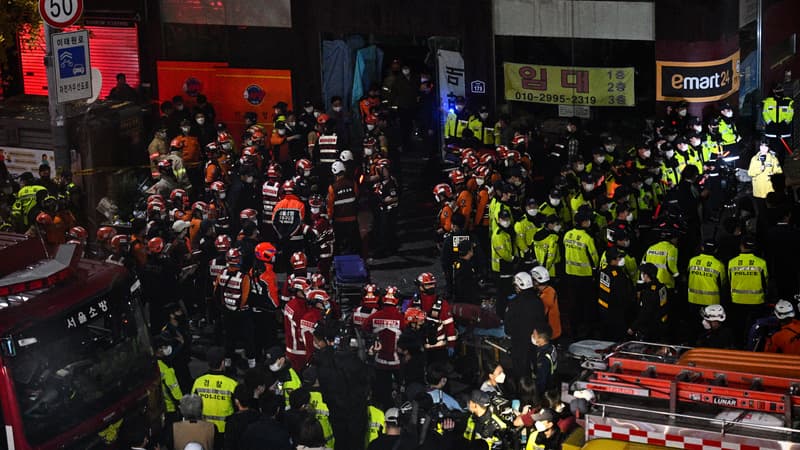The balance continues to grow. This Saturday, more than 140 people died in a district of Seoul, South Korea, on the sidelines of the festivities organized on the occasion of Halloween. A gigantic movement of crowds is at the origin of the drama.
BFMTV.com takes stock of what we know about this stampede and its aftermath.
· What happened?
As Halloween celebrations were in full swing on the streets of Seoul on Saturday, drawing large numbers of people to the capital, a large movement of crowds took over revelers in the Itaewon district in central Seoul.
Photos released by Yonhap showed more than a dozen people lying on a street, with rescuers performing CPR on some of them, while police cordoned off the crowd. However, according to video footage, around 20 bodies were covered with sheets or blankets as rescuers did not attempt to revive them. Other victims were evacuated on stretchers to ambulances.
The Yonhap news agency quoted an unidentified witness as saying the victims were crushed by the movements of the crowd. “People were on top of each other. Some were gradually losing consciousness, others were obviously dead,” said this source.
This year’s Halloween celebrations are the first since the Covid-19 pandemic, in which South Koreans were forced to wear masks outdoors.
· What is the current balance?
According to a latest report from the authorities, 146 people died after the movement of the crowd and another 150 were injured.
“As of 4 am (7 pm GMT on Saturday), 146 people were killed and 150 injured,” Choi Seong-beom, a fire official in the South Korean capital, told reporters at the scene.
“The high number of victims is due to the fact that many people were trampled during the Halloween party,” he added, believing that the number of victims could still rise.
· What are the means of aid committed?
A fire department spokesman said 140 ambulances had been dispatched to the scene after the incident to treat the victims.
Given the very high number of victims, the president of South Korea, Yoon Suk-yeol, asked to prepare hospitals to receive the wounded, as reported by the country’s presidency on Saturday. As for Seoul Mayor Oh Se-hoon, who was visiting Europe, he decided to return in a hurry due to the tragedy, according to Yonhap.
· Why did the authorities first speak of “cardiac arrest”?
Before talking about the deaths following the movement of the crowd, firefighters in the South Korean capital first announced that dozens of people had suffered cardiac arrest.
A choice that finds an explanation in the medical customs of the country: in South Korea, relief officials speak of cardiac arrest as long as a doctor has not officially declared a person dead.
· What are the reactions at the international level?
Just hours after the tragedy, as the death toll continues to rise, President Emmanuel Macron tweeted in support of “all the Korean people.” He expresses this Saturday night “a touching thought for the inhabitants of Seoul”.
“France is by your side”, added the Head of State.
In the process, Prime Minister Elisabeth Borne underlined her “very strong emotion.” “All my thoughts are with the victims, their loved ones and the Korean people”, always through the social network.
Britain’s newest prime minister, Rishi Sunak, also tweeted to lament the “terrible news from Seoul”.
“Our hearts go out to those who are currently responding and to all South Koreans at this very difficult time,” he continued.
Source: BFM TV


